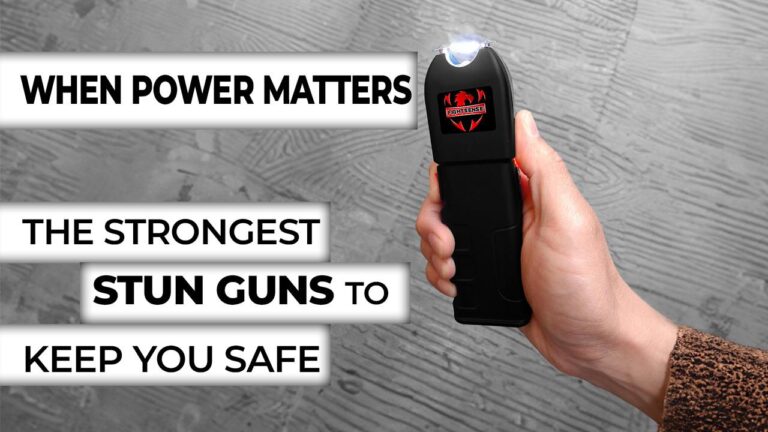Table of Contents
- Understanding the Risks of Water Exposure on Your Stun Gun
- Immediate Steps to Take When Your Stun Gun Gets Wet
- Drying and Cleaning Methods to Safely Restore Functionality
- Preventative Measures to Protect Your Stun Gun from Moisture Damage
- To Conclude
Understanding the Risks of Water Exposure on Your Stun Gun
Stun guns are designed with electrical components that are highly sensitive to moisture. When water penetrates the device, it can cause short circuits, corrosion, and permanent damage to the internal circuitry. This not only renders the stun gun ineffective but also poses a potential safety hazard, such as unintended discharges or complete device failure when you need it most. Additionally, water can compromise the battery connections, accelerating wear and reducing the overall lifespan of your device. Understanding these risks highlights why immediate attention is crucial if your stun gun becomes wet.
Preventing damage starts with recognizing the vulnerabilities. Moisture interferes primarily with electrical conductivity, making the stun gun unreliable. It is important to minimize exposure by:
- Keeping the stun gun in a waterproof case or protective pouch.
- Avoiding use in heavy rain or humid environments without proper protection.
- Regularly inspecting seals and moisture barriers for signs of wear.
Immediate Steps to Take When Your Stun Gun Gets Wet
First and foremost, disconnect your stun gun from any power source. Safety is paramount; ensuring that the device is completely powered off reduces the risk of accidental discharge or electrical shock during the drying process. Avoid pressing any buttons or attempting to test the device while it’s still wet. Next, gently pat the exterior with a dry, absorbent cloth to remove as much moisture as possible without spreading water into internal components.
Once you’ve removed surface moisture, place the stun gun in an environment conducive to drying out thoroughly. Consider these steps:
- Put it in a sealed container with silica gel packets or uncooked rice to help absorb internal moisture.
- Keep it at room temperature; avoid using a hairdryer or any heat source that could damage sensitive parts.
- Leave it to dry for at least 24 to 48 hours to ensure all moisture is evaporated before attempting to use it again.
Following these actions carefully will help salvage your device and maintain operational safety.
Drying and Cleaning Methods to Safely Restore Functionality
When your stun gun has been exposed to moisture, the first step in restoration is a careful drying process. Avoid using direct heat sources like hairdryers or ovens, as excessive heat can damage sensitive electronic components. Instead, gently pat the device with a soft, absorbent cloth to remove surface water and then place it in a sealed container filled with silica gel packets or uncooked rice. These materials naturally draw out moisture without causing harm. Leave the stun gun submerged in this drying agent for at least 48 hours to ensure thorough moisture removal.
Once the stun gun is dry, it’s critical to perform a meticulous cleaning to prevent corrosion and maintain functionality. Use a soft brush or compressed air to clear away any debris from the electrodes and casing. Wiping down the exterior with a slightly damp cloth and a mild isopropyl alcohol solution (70%) can effectively disinfect and evaporate quickly, reducing the risk of residue build-up. Never soak the stun gun or submerge it in any cleaning solution, as internal damage may occur. Finally, before testing or charging, inspect the device for any visible signs of wear or corrosion and consult the user manual or a professional technician if you observe anything unusual.
Preventative Measures to Protect Your Stun Gun from Moisture Damage
To safeguard your stun gun against moisture damage, start by storing it in a dry, cool place away from any sources of humidity. Consider investing in a water-resistant case or pouch for added protection, especially if you carry your device outdoors or in unpredictable weather. Additionally, always check for any exposed openings or damage that might allow water to seep in-seals and covers should be intact and securely fastened at all times.
When handling your stun gun near water, it’s essential to take proactive steps such as:
- Keeping it away from pools, rain, or wet surfaces
- Wiping down the device immediately if it gets damp
- Using silica gel packets in your storage case to absorb stray moisture
- Inspecting your stun gun regularly for any corrosion or damp spots
To Conclude
In the end, while a stun gun is a reliable tool for personal safety, proper care and maintenance are crucial-especially when it comes to keeping it dry. If your device does get wet, following expert safety tips can help you avoid damage and ensure it remains functional when you need it most. Remember, never attempt to use a wet stun gun, and always allow it to dry thoroughly before testing or carrying it again. By handling your stun gun with the right precautions, you’re not only protecting your investment but also prioritizing your safety. Stay informed, stay prepared, and stay safe.Check Our Other Blogs
- StunGun – Your Trusted Source for Stun Guns, Laws, and Self-Defense Tips
- PepperSprayLaws – Your Trusted Resource for Pepper Spray Information
- StunGunLaws – Your Trusted Guide to Stun Gun Legality and Safety





